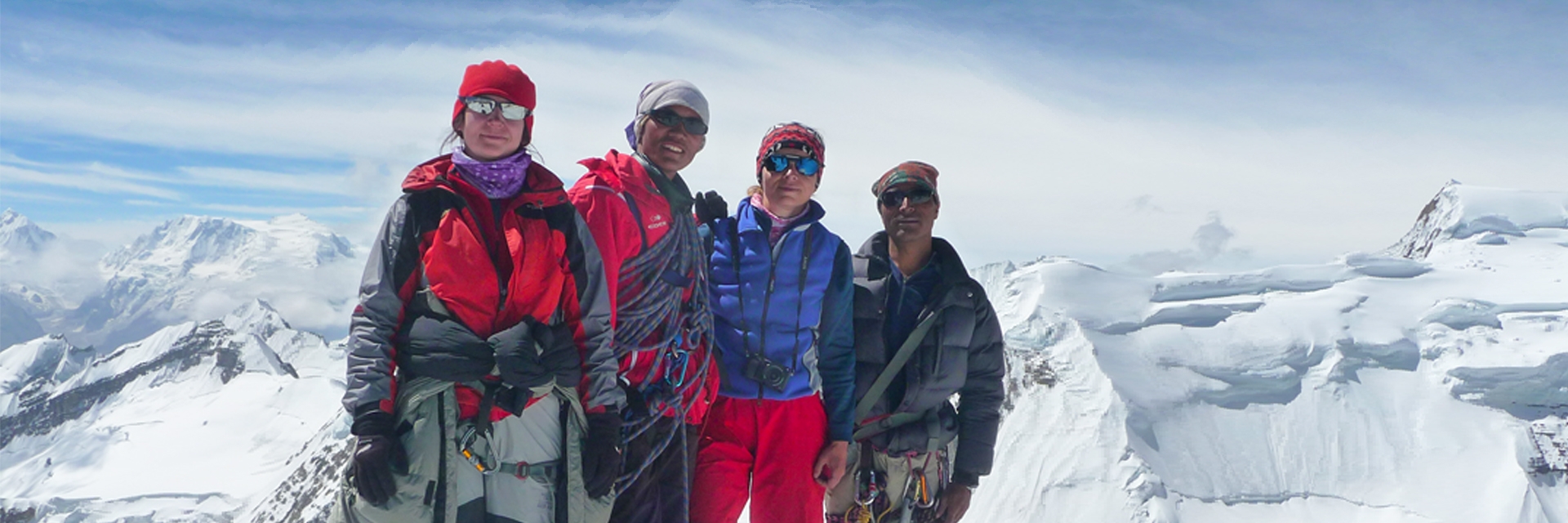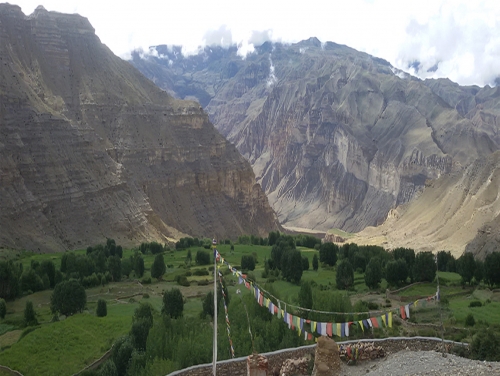About The Adventure Saribung Pass Trip
Ultimate Upper Mustang Saribung Pass Trek (6,050 m) and Saribung peak climbing in Himalaya (6,346 m) are newly explored, in the western part of Nepal. Saribung is situated on the border of Mustang and Manang, which lies in the remote Damodar Himal, closed to the border of Tibet. Saribung Pass Trek has been a challenging and popular mountaineering and trekking route with a beaten track and exhilarating pass. Upper Mustang dwells in the restricted area of Mustang; a special permit is necessary to visit the Upper Mustang. The trails here are rugged, cutting high into cliffsides and passing through small Buddhist villages. The views of the peaks like Mt. Dhaulagiri, Mt. Manaslu, Mt. Annapurna, and many other peaks look spectacular during the trek.
Overview
Saribung is one of the remote parts of Nepal. No sign of modernization can be seen in this area. In 2006, it was first open for trekking and was known to only a few trekkers. Saribung Pass Trekking is an ideal experience to travel through an incredibly high mountain of a country. This trek includes the exploration of the restricted Upper Mustang and hidden Nar Phu Valley. Both are exciting destinations for travelers. Damodar Kunda, Nar Phu Valley, Upper Mustang, and Jomsom add to the glory of this trek. The trail will traverse you through Saribung Pass, from where you can savor the majestic views of Mt. Annapurna II (7,937 m/26,040 ft.), Mt. Dhaulagiri (8,167 m/26,795 ft.) Mt. Cheo (6,812 m/22,349 ft.), Mt. Peri (6,296 m/20,656 ft.), Mt. Himlung (7,126 m/23,379 ft.), Mt. Ratnachuli (7,035 m/23,080 ft.), and many more.
Trip to Saribung Pass trial is the mixture of rugged, ancient culture, cutting high into cliffsides and passing through Buddhist villages which are still untouched for centuries. We will cross numerous high passes like De Hults Pass (5,283 m), Saribung Pass, and many other passes. We will be welcomed with a fabulous journey that leads to high windswept terrain, an extension of the vast South West Tibet Plateau. As you cross Saribung Pass, this trek offers adventurous souls the opportunity to travel many high mountains passes often covered with snow and see remote valleys situated between Damodar Kunda and Nar-Phu Valley. This trek provides incredible diversity in scenery, beautiful landscapes, cultures, interaction with local and geographical variations.
Damodar Kunda is a famous lake in Upper Mustang that has massive importance amongst the Hindu pilgrims. Many people around the globe come to visit this place yearly for religious significance. Likewise, Nar Phu Valley is a highlight of the Saribung Pass Trek. Due to its wild landscape, many trekkers embrace this place. The ancient monastery, natural and cultural diversity with religious and graphical change is a unique trip feature.
On the way to Saribung Pass Trek, you will experience the Tibetan culture thrives in small villages and monasteries. It is keen for the tourist who had seen it for the first time and experience the scale and grandeur of the high plateau and solitude this region has to offer. You will be blessed to experience the diversity of local culture in this region.
Saribung Pass Trek Route
The trek begins with the scenic drive from Kathmandu to Pokhara. As we reach Pokhara, we take a short flight to Jomsom, and then hiking starts toward the north to the ancient capital Lo Manthang, which is the capital of Mustang Valley. Our route heads towards Damodar Kunda to the north (close to the Tibetan boundary) and descends towards the magical hidden valley of Phu after crossing Saribung Pass.
During this trek, the route involves breathtaking scenery of the wild and isolated region of Mustang Valley. You will be blessed to experience eroded canyons, typical Tibetan villages, Buddhist Gompas (monasteries), cave monasteries in the cliffs, and old cave settlements. Furthermore, the view of massive Dhaulagiri (8167m), peak Tilicho, Nilgiri, and Tukuche is outstanding. A relaxing stay at Pokhara with the idea of the massif Annapurna range will be worth it after a trek.
Saribung Pass Trek Difficulty
Saribung Pass Trek is a rough trail that passes some of the ancient Tibetan villages to the high cliffs. On the way to the top, you may have to go through many high passes with ice and ridges, making this trek even extra challenging. The path is pretty challenging, as can you find yourself strolling through many tracks with ice folds from Damodar Kunda to Nar Phu valley.
Saribung Pass Trek Weather
Best Seasons for Saribung Pass Trek in Nepal are primarily two seasons which are spring and autumn. Every season has its own unique feature. Neither too cold nor too hot, have scenic views of the gigantic mountains enhanced with the pleasant weather. To spend the best time of life in the world during the best seasons, a vacation in Nepal is worth it. The crystal clear visibility of the mountains and Himalayas under the extraordinarily blue sky seems perfectly eye-soothing. Trekking in Nepal Himalayas will embrace life and bring a fantastic, gratified smile. Plan the holiday to visit Nepal, pack your backpacks, and fly to Nepal. We will always be willing to greet you and arrange everything to have a wonderful and comfortable visit.
Spring (March to May)
The spring season is a blessing of nature in Nepal. During this period, the flowers bloom and make the hillocks and mountains look colorful. The spring season is considered to be one of the best seasons to trek in Nepal. The days will be warmer, but the nights and the early mornings may be colder. The temperature fluctuates typically from 6 to 25 degrees. During trekking, it is advised to wear the clothes in layers as the fluctuating weather is irregular.
Summer (June to mid-September)
Summer is always warmer and hot but humid. This is the best season for trekkers and travelers who have an extreme interest in botany as a species of floras will be blooming everywhere. The valleys and the hills will be covered with amazingly gorgeous flowers and lush vegetation. The temperature of 20 goes higher up to 35 degrees. So it is pretty necessary to keep yourself hydrated throughout the trip. Even though summertime is the best time to trek in Nepal, there may be the chance to enjoy rainfall during the summer. So it is better to be equipped up all the time during the trip. The end of June and July are the summer months, followed by monsoon summer until September. During the monsoon in Nepal, there are heavy rainfalls with high humidity. The skies are full of fogs, mostly blocking the fantastic views of the Himalayas. It might become difficult to walk.
Autumn (mid-September to November)
The autumn season is another best season to trek in Nepal. The skies are fair, and the temperature ranges from 0 to 25 degrees. The views of the Himalayas and the surrounding valleys are flawless. The lush vegetation, great weather, and peaceful surrounding make this season special. It’s neither too cold, nor too hot, so many travelers prefer this season to enjoy their trek in Nepal. September and November fall in the autumn season.
Winter (December to February)
Chilling weather with snowfall and sometimes snowstorms are the specialties of the winter season. The climate at higher altitudes is milder in the daytime but colder at night and morning. The sky is clear and blue, offering remarkable glimpses of the Himalayas. Sudden snowfall, avalanches, or snowstorms may be challenging and hamper the trip. Despite these barriers, some adventure lovers find this season the best season for trekking in Nepal. December to February are the months that fall under the winter season.
Saribung Pass Trek Cost
When you are thinking about exploring Saribung Peak, there will be many factors to consider. It includes the best route, time, how fit do we need to be? But one of the most important confusion will be, “How much does Saribung Peak Trek cost?”
Whether you are budget dependent or not, it is essential to consider how much you want to pay for the trip and what is the actual cost. The baseline cost of the Saribung Peak Trek will depend on the number of variables. Your cost will change based on how comprehensive you want your trip to be.
On average Saribung Peak, the trek will generally be 20-24 days, and the cost is generally somewhere between USD 5100 to USD 4946. This price includes domestic flights, trekking permits, meals, professional trekking guides, porters, accommodation, entry fees, and others. You will get some discounts if you are in groups. The cost of Saribung Peak Trek highly depends upon traveling as private or in a group.
The permit cost for Saribung Peak Trek depends on the seasons and the number of days you will spend in this region. To trek to the Manaslu region, you will need 3 kinds of permits issued by the Government of Nepal.
Saribung Pass Trek Altitude
Photo: Altitude Chart


